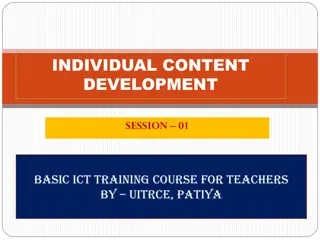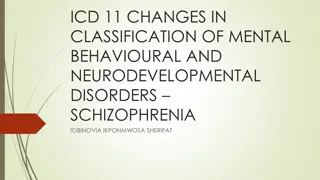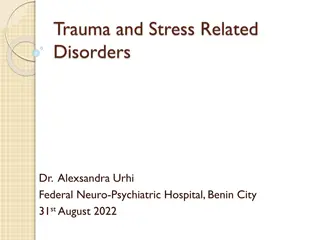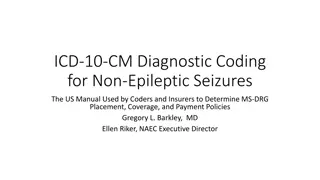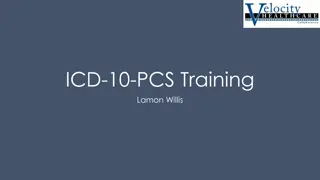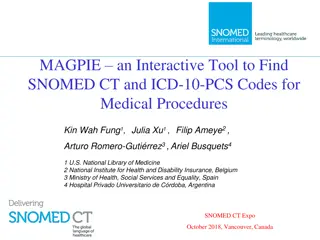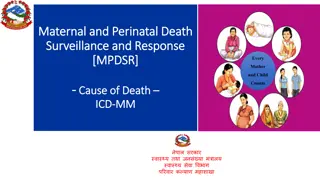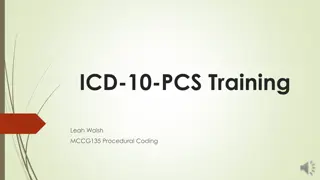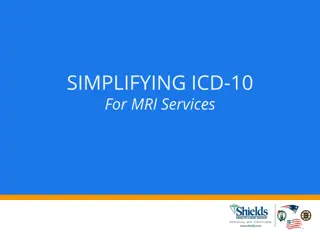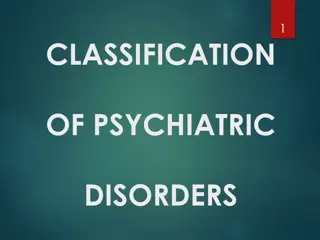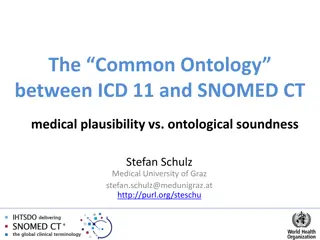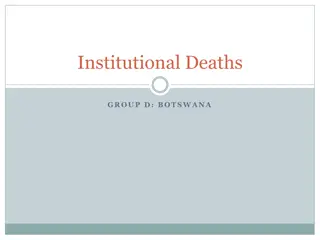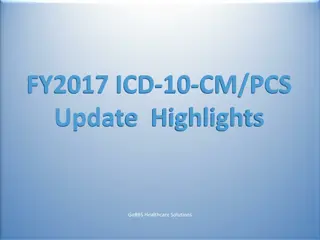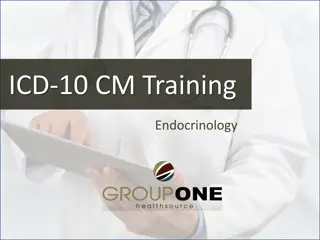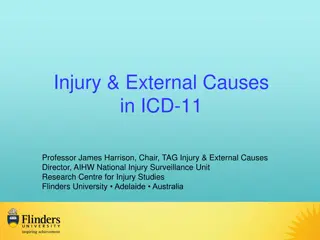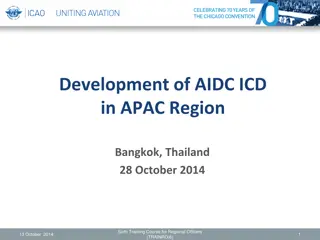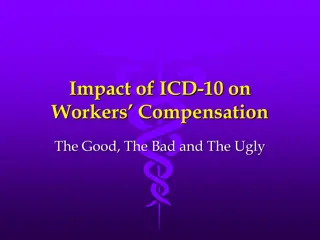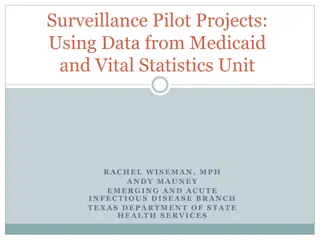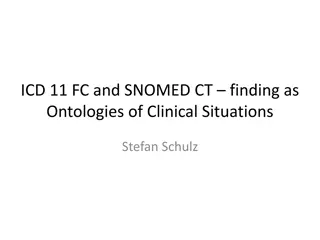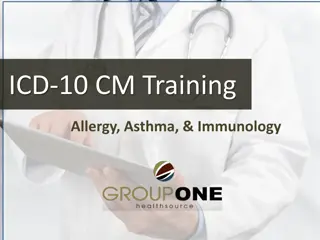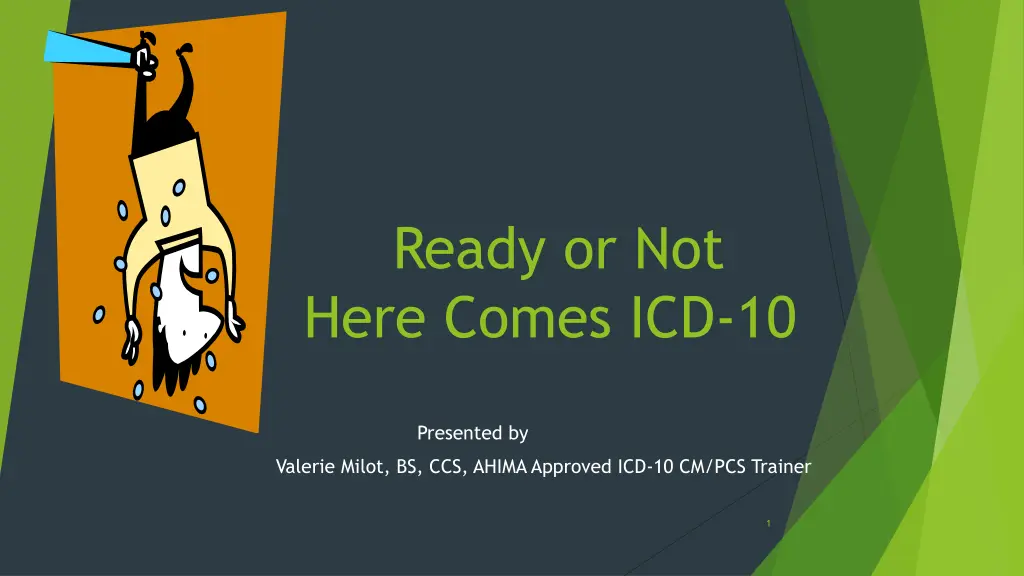
ICD-10 Implementation: Key Details Revealed
Uncover important insights on the upcoming transition to ICD-10, including objectives, reasons for the change, implementation details, and differences from ICD-9. Explore the practical guidance provided by Valerie Milot, an experienced ICD-10 trainer, to ensure compliance and reduce reimbursement issues when the new coding system goes live.
Download Presentation

Please find below an Image/Link to download the presentation.
The content on the website is provided AS IS for your information and personal use only. It may not be sold, licensed, or shared on other websites without obtaining consent from the author. If you encounter any issues during the download, it is possible that the publisher has removed the file from their server.
You are allowed to download the files provided on this website for personal or commercial use, subject to the condition that they are used lawfully. All files are the property of their respective owners.
The content on the website is provided AS IS for your information and personal use only. It may not be sold, licensed, or shared on other websites without obtaining consent from the author.
E N D
Presentation Transcript
Ready or Not Here Comes ICD-10 Presented by Valerie Milot, BS, CCS, AHIMA Approved ICD-10 CM/PCS Trainer 1
DISCLAIMER This material is designed and provided to communicate information about the implementation of ICD-10. The author is not providing or offering legal advice but, rather, practical and useful information and tools to achieve compliant results in the area of clinical documentation, data quality, and coding which will help to reduce reimbursement delays & denials when ICD-10 goes live. Every reasonable effort has been taken to ensure that the educational information provided is accurate and useful. 2
Objectives The five W s Dual Coding Changes & Future Reimbursement Implications Comparisons 3
WHY are we doing this now? The United States is the ONLY industrialized country that is not using ICD-10 for our coding & reporting of diseases, illnesses, & injuries. Many Countries have been using ICD-10 for their case mix for decades. Canada was the last country & they have been using ICD-10 for their case mix since 2001. By changing to ICD-10-CM/PCS, the US healthcare system s will be able to more accurately gauge healthcare services, improve the monitoring and surveillance of diseases, and produce quality healthcare data to improve patient outcomes. 4
When do we have to As of today- the implementation date is . OCTOBER 1, 2015- JUST 321 more days 5
WHERE The entire country will start using ICD-10 when submitting health claims when the implementation date comes A few exceptions to the mandate for using ICD-10 are: Worker s Compensation Carriers may choose to continue to use ICD-9 Dentists may or may not be required to use ICD-10 when submitting their electronic claims (In combination with their CDT (current dental terminology) codes Although required, some State Medicaid systems will not be ready 6
Whats the Difference? Diagnosis ICD-9-CM ICD-10-CM 3-5 Digits or characters 3-7 Digits or characters 1st character is alpha (all letters are used except the u ) 1st character is numeric (with exception of E & V codes) 2nd-7th characters can be alpha and/or numeric 2nd-5th characters are numeric Decimal is placed after the first 3 characters Decimal is placed after the first 3 characters 17 chapters and the V & E codes are supplemental 21 chapters and the V & E codes are NOT supplemental Approximately 14,000 diagnosis codes Approximately 69,000 diagnosis codes 7
Diagnosis Example ICD-9-CM Pressure ulcer codes ICD-10-CM Pressure ulcer codes 150 codes Show more specific location as well as depth, including: L89.131 Pressure ulcer of right lower back, stage 1 L89.132 Pressure ulcer of right lower back, stage 2 L89.133 Pressure ulcer of right lower back, stage 3 L89.134 Pressure ulcer of right lower back, stage 4 L89.139 Pressure ulcer of right lower back, unspecified stage L89.141 Pressure ulcer of left lower back, stage 1 L89.142 Pressure ulcer of left lower back, stage 2 L89.143 Pressure ulcer of left lower back, stage 3 L89.144 Pressure ulcer of left lower back, stage 4 L89.149 Pressure ulcer of left lower back, unspecified stage L89.151 Pressure ulcer of sacral region, stage 1 L89.152 Pressure ulcer of sacral region, stage 2 9 location codes (707.00 707.09) Shows broad location, but not depth (stage) 8
Whats the Difference? Procedure ICD-9-CM (Volume 3) ICD-10-PCS Minimum characters is 7 Minimum characters is 3 Maximum characters is 7 Maximum characters is 4 **Alphanumeric format ** **Numeric format ** NO Decimal point Decimal point Approximately 71,920 procedure Codes Approximately 3,000 procedure Codes 9
Procedure Example ICD-9-CM (Procedure) ICD-10_PCS 86.04, Other incision with drainage of skin and subcutaneous tissue OH96XOZ, Drainage of back skin, with drainage device, external approach OH96XZZ, Drainage of back skin, external approach Doesn t differentiate between skin or subcutaneous tissue PLUS- an additional 264 other codes specifying location (back, left arm, genitalia, etc.) the depth (skin or subcutaneous) the approach (external, open, percutaneous, percutaneous endoscopic) and drainage device. Doesn t specify site (scalp, left arm, abdomen, buttocks) 10
Who will be Ready Providers Hospitals Payers Vendors It will depend on where you are at with implementation this time. October 1st will be here very soon 11
Dual Coding When do you start- It s never too soon! How often- Depends on the type of Facility/Provider At a minimum recommendation is monthly, bimonthly for at least one day. By starting earlier- will minimize some of the back log on the Health Care Organization as staff will be comfortable & ready for the Go Live date Starts identifying needs of coding, provider, & system risks/issues Make sure you are logging any concerns, issues, risks identified- Track your information on spreadsheets then sort to identify patterns of areas to determine the system, the condition(s), or the providers so education and corrections can be done BEFORE the implementation date Clinical Documentation Improvement Specialist is crucial for success 12
How long will dual coding/billing be needed Within the Industry, you will hear a variety of timelines. There is the potential the dual coding & dual systems may be indefinite Majority of Medical claims: minimum is potentially up to two years, depending on filing limits of the various carriers HOWEVER- because of various Regulatory agencies such as the RAC s, MAC s, & even the OIG reviews, it may be longer because of appeals on denials & take backs If Worker s Carriers chose not to make the transition, the dual coding & it s costs to manage two systems may be indefinite 13
Estimated Costs of Implementation CMS estimates the costs to the private sector to exceed $130 million System upgrades throughout the organization may be needed For example- dietary, pharmacy, management, OR systems all may use diagnosis and/or codes to perform their duties Reduction in productivity in coding & billing AHIMA suggests after ICD-10 coders will be 50% slower for the first 3 months. Various figures have indicated even after staff have become comfortable with new processes, volumes will not return to ICD-9 numbers Expect a 50 percent increase in provider queries AAPC agrees & indicates that with current documentation, only 50 percent of encounters could be coded under ICD-10 14
Hidden Costs with Implementation Education & Training Staff throughout the organization (not just coding) Providers Vendors may not be able or ready to accept ICD-10 which will delay reimbursements Creating/revising current Query processes because the volume will be very high once implementation has occurred Potential impact to Case Mix Index Staffing shortages & overtime Will work need to be Outsourced 15
How soon will we start seeing changes in Reimbursement Time after implementation will truly define how much reimbursement will change If you spend the time now to determine the areas needed for improvement, it will minimize- The volume of queries to providers Reduce delays in completing visits (aka- DNFB) Reduce denials from Carriers CMS has already been providing information on what the DRG (as well as CC and MCC s) will be on specific final diagnosis 16
Comparisons Following industries recommendations is strongly suggested. You will need to review your top ten (or twenty if possible) current DRG s. Have them dual coded to determine: Potential impact with the new coding structure If current documentation supports the necessary information needed to code to the highest level of coding accuracy Current processes such as forms, query processes and policies will support the new structure Let s take a look at a couple of examples on the differences . 17
Example 1: Pressure ulcer of buttock stage III with gangrene (both present on admission) (ICD-10-CM guidelines specify a sequencing change that changes the principal Dx and the MS-DRG) ICD-9 ICD-10 707.05 Pressure ulcer, buttock I96 Gangrene, NEC 707.23 Pressure ulcer, stage III (MCC) L89.303 Pressure ulcer of unspecified buttock, stage III (MCC) 785.4 Gangrene (CC) MS-DRG 299 Peripheral vascular disorders W MCC MS-DRG 592 Skin Ulcers W MCC RW 1.4753 RW 1.4072 18
Example 2: Pneumonia patient with NSTEMI MI two weeks ago (treated during the inpatient stay) (ICD-10-CM defines AMIs as 4 weeks, and classifies them differently, resulting in an MCC for this example) ICD-9 ICD-10 486 Pneumonia J18.9 Pneumonia 410.72 subendocardial infarction, subsequent episode of care I21.4 Non-ST elevation (NSTEMI) myocardial infarction (MCC) MS DRG 195 Simple pneumonia w/o CC/MCC MS DRG 193 Simple pneumonia w MCC RW 0.7096 RW 1.4796 19
QUESTIONS? So who has a headache now Will it really happen If it does- Will you be ready Does anyone have any questions 20
Helpful Resources/Links from CMS http://cms.gov/Medicare/Coding/ICD10/index.html http://www.roadto10.org/quick-references/ http://cms.gov/Medicare/Coding/ICD10/ICD-10-MS-DRG-Conversion-Project.html http://cms.gov/Medicare/Coding/ICD10/Medicare-Fee-For-Service-Provider-Resources.html http://www.cms.gov/Medicare/Coding/ICD10/Downloads/ICD-10Overview.pdf http://www.roadto10.org/action-plan/phase-2-train/common-codes-family-practice/ http://www.cms.gov/Medicare/Coding/ICD10/index.html http://www.cms.gov/Medicare/Coding/ICD10/Medicare-Fee-For-Service-Provider- Resources.html http://cms.gov/Medicare/Coding/ICD10/CMSImplementationPlanning.html http://www.cms.gov/Medicare/Coding/ICD10/ICD-10ImplementationTimelines.html http://www.cms.gov/Outreach-and-Education/Medicare-Learning-Network- MLN/MLNEdWebGuide/Downloads/Guided_Pathways_Provider_Specific_Booklet.pdf http://library.ahima.org/xpedio/groups/public/documents/ahima/bok1_049750.hcsp?dDoc Name=bok1_049750 21
Contact Information Presentation by Valerie Milot, BS, CCS, AHIMA Approved ICD-10 CM/PCS Trainer, Director of Physician Services Tel: (603) 530-1459 Medical Reimbursement Specialists, LLC Codeaid LLC PO Box 486 266A Summer St Bristol, NH 03222 Main Office Tel: 603-217-0006 FAX: (603)-947-1458 www.mrsnh.com 22
References American Academy of Professional Coders, https://www.aapc.com/ American Health Information Management Association, http://www.ahima.org/icd10/ California Health Information Management Association, June 2014 presentation obtained at http://californiahia.org/sites/californiahia.org/files/docs/events/handouts/convention/mon-red-100.pdf Center for Medicare and Medicaid Services, see the previous resources slide for various sites/documents used for this presentation UASI, Stanfill, Jan 2012, obtained at http://www.uasi-qc.com/insights-education/news/article/power-10- reimbursement-impact-icd-10 23

